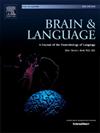Do newborns detect prosodic violations in an unfamiliar language at birth?
IF 2.3
2区 心理学
Q1 AUDIOLOGY & SPEECH-LANGUAGE PATHOLOGY
引用次数: 0
Abstract
Experience with language starts prenatally, as the intrauterine environment allows speech prosody to get through. Martinez-Alvarez and colleagues (2023) demonstrated that newborns detect utterance-level prosodic violations in the language they heard prenatally, French. It remains unknown, however, whether this discrimination ability requires prenatal experience with a given language or whether newborns have an early sensitivity to the shapes of prosodic contours that extends beyond prenatal experience. To this purpose, we tested infants exposed prenatally to Italian with the French stimuli of Martinez-Alvarez et al. (2023), and we measured their brain responses with fNIRS. We found that Italian-exposed newborns discriminate between standard and deviant prosodic contours in French, activating right hemispheric areas specialized for the processing of prosody in adults. However, the time course and the localization of the effect were different from those found in French newborns. This suggests that an early sensitivity to prosodic contours may be modulated by prenatal experience at birth.
新生儿在出生时是否察觉到不熟悉语言的韵律违反?
语言的体验从胎儿时期就开始了,因为子宫内的环境允许语言韵律通过。Martinez-Alvarez和他的同事(2023)证明,新生儿在出生前听到的语言——法语中,能够察觉到话语层面的韵律违规。然而,尚不清楚这种辨别能力是否需要产前的语言经验,或者新生儿是否对韵律轮廓的形状具有早期的敏感性,这超出了产前的经验。为此,我们用Martinez-Alvarez等人(2023)的法语刺激对产前接触意大利语的婴儿进行了测试,并使用近红外光谱测量了他们的大脑反应。我们发现,接触意大利语的新生儿能够区分法语的标准韵律轮廓和异常韵律轮廓,激活了专门处理成人韵律的右半脑区域。然而,其作用的时间过程和局部与法国新生儿不同。这表明,早期对韵律轮廓的敏感性可能受到出生时产前经验的调节。
本文章由计算机程序翻译,如有差异,请以英文原文为准。
求助全文
约1分钟内获得全文
求助全文
来源期刊

Brain and Language
医学-神经科学
CiteScore
4.50
自引率
8.00%
发文量
82
审稿时长
20.5 weeks
期刊介绍:
An interdisciplinary journal, Brain and Language publishes articles that elucidate the complex relationships among language, brain, and behavior. The journal covers the large variety of modern techniques in cognitive neuroscience, including functional and structural brain imaging, electrophysiology, cellular and molecular neurobiology, genetics, lesion-based approaches, and computational modeling. All articles must relate to human language and be relevant to the understanding of its neurobiological and neurocognitive bases. Published articles in the journal are expected to have significant theoretical novelty and/or practical implications, and use perspectives and methods from psychology, linguistics, and neuroscience along with brain data and brain measures.
 求助内容:
求助内容: 应助结果提醒方式:
应助结果提醒方式:


